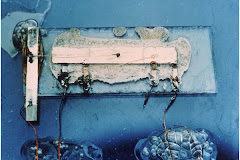Carole Slade
Book Review
María Vela y Cueto, Autobiography
and Letters of a Spanish Nun. Edited by Susan Diane Laningham. Translated by
Jane Tar. The Other Voice in Early
Modern Europe: The Toronto Series, Vol. 51, ITER Academic Press & Arizona
Center for Medieval and Renaissance Studies (Toronto, Canada & Tempe,
Arizona, 2016), 192 + xiv pp. ISBN: 9780866985598
1> The selected writings of María
Vela y Cueto (1561-1617) presented in Autobiography
and Letters of a Spanish Nun make a valuable addition to the growing chorus
of women visionaries and mystics from sixteenth-century Spain: Mother Juana de
la Cruz (1481-1534), Mother Ana of San Bartolomé (1549-1626), and Cecilia del
Nacimiento (1570-1647), all recently published in The Other Voice in Early
Modern Europe series, as well as the already widely translated St. Teresa of
Avila (1515-82). Although their texts have many conventions and topoi in
common, the opportunity to read them in concert allows appreciation of the commonalities
as well as important distinctions among them.
2> Susan Diane Laningham, editor
of this volume, provides a substantive introduction that includes a brief
biography of Vela and a survey of the historical moment and religious culture
that fostered women’s writing of spiritual autobiographies and other genres drawn from their spiritual experiences. Laningham’s copious footnotes plunge
deeply and judiciously into secondary literature. Auxiliary materials include a
chronology, two brief excerpts from an early hagiography of Vela, and eleven letters,
most of them written by Vela to the older of her brothers, a friar in a Cistercian
monastery. An index that comprehends primary and secondary materials helps the
reader to follow her complicated spiritual journey. To readers who
want additional detail or analysis of Vela’s life and writings I recommend two
excellent articles by Laningham, listed in the bibliography.
3> This volume includes the full
text of Vela’s autobiography, clearly and meticulously translated by Jane Tar, and
amply annotated. The only previous English translation of Vela’s autobiography,
published as The Third Mystic of Avila
by Frances Parkinson Keyes in 1960 (out-of-print), does not include the
complete text. Tar worked from the 1961 edition by Olegario González Hernández,
who drew together the three extant versions: the autograph manuscript and two
copies, one probably made soon after her death and the other certified by the
bishop of Avila in 1744. Laningham’s and Tar’s version includes the chapter
divisions and summaries added in 1744. A look at Vela’s Spanish confirms their
assertion that her prose is more coherent and correct than St. Teresa’s. I
would add that Teresa’s prose is generally more metaphorical and emotional.
4> In 1576, aged fifteen, Vela
entered the Cistercian convent of Santa Ana in Avila, which had had close connections
with royalty and aristocracy since its foundation in 1320. Vela’s family ranked
just below the high nobility: many of her family members held important offices
in the church, court, and colonies. By comparison with most women of the time,
Vela was highly cultivated, though not formally educated. She played the organ,
knew Latin relatively well, and read widely in Spanish devotional literature. Vela
initially wanted to remain in the world, as her mother did, even after the
death of husband and despite her notable piety. Vela remained undecided until her
mother received a sign that Christ did not want her, but rather her daughter, for
His own. Both of Vela’s sisters and her paternal aunt also joined the convent. When
they moved into Santa Ana, they would have expected to retain some privileges
of nobility, including the title of Doña.
5> In the introduction Laningham suggests
some contexts for understanding Vela’s notoriously bizarre reactions to spiritual
experience and her troublesome resistance to convent rule. Those women who entered
convents for lack of alternatives or with familial pressure often could not
adjust easily to an ascetic, communal life and permanent separation from their
families. The pressure for evidence of piety caused some, women in particular, to
adopt diets and to self-administer bodily mortifications that weakened their physical
and mental health. In
a deeply misogynistic age, the Church considered
women particularly susceptible to deception and seduction by the devil; as a
result they often suspected demonic instigation of the very mystical favors
they encouraged and rewarded.
6> Vela represents an instance of Caroline Walker
Bynum’s finding in Holy Feast, Holy Fast:
The Religious Significance of Food to Medieval
Women (1982) that religious women’s food practices,
whether eating or fasting, referred to the Eucharist. When Vela could not take
communion as often as she wished, her jaws would lock closed, preventing her
from eating, drinking, or speaking. The convent engaged a dentist to pry Vela’s
jaw apart, but when he could not make an opening except by pulling teeth, he declined
to inflict such pain. In addition to lockjaw, somatic manifestations of her spiritual
conflicts included fevers, seizures, fainting spells, levitations, and falls. For
more than twenty years such maladies defied the attempts of abbesses, confessors,
physicians, and an exorcist to relieve her suffering or control her conduct.
7> Like many of the women mystics
of her time, Vela came under scrutiny of the Inquisition. In 1603, twenty-seven
years after Vela had entered Santa Ana, several of her sister nuns made
complaints about her behavior to the Inquisition, which then designated Father
Juan de Alarcón, prior of a Cistercian monastery in Avila, to question her. Deeply
affected by Vela’s suffering and finally convinced of her sincerity, Alarcón certified
her sanity and piety. He later wrote her a consolatory letter, included in this
volume. Few if any disruptive nuns would have received a written personal response
from an investigator for the Inquisition: it seems likely that Vela’s
aristocratic background and family connections contributed to his sympathy.
8> Vela began seeing her final
confessor, Father Miguel González Vaquero, secretly, not because he had questionable
credentials but because she had already run through so many confessors. One confessor gave up on her after two months,
another after two weeks, and another took just fifteen minutes to decide
against directing her. Vaquero ordered her to write a general confession
(this spiritual autobiography) in 1607. In 1608 she completed the first part,
chapters 1 through about two-thirds of chapter 9, the point identified in a
footnote. In 1610, Vela added material that seems motivated by a fresh
determination to portray herself as a saint. Near the end of Chapter 9, she interpolates
a new section, a dialogue between God and Vaquero interspersed with divine
locutions addressed to her. Including Vaquero in her conversations with God
elevates him also into the mystical arena. In Chapter 10 Vela tells of
receiving the kind of privileged knowledge that often served to provide
evidence of sainthood: mysteries such as the Trinity, the Incarnation, the
Crucifixion, and divine grace. In an epilogue added three years before her
death, Vela quotes a divine avowal of her eternal destiny as a Bride of Christ.
9> When Vela died, in 1617, Vaquero
placed the manuscript of her spiritual autobiography in her coffin, thus effectively
silencing her voice until her body was exhumed in 1623 and the Santa Ana nuns
rescued her text. In 1618, drawing on her autobiography as well as earlier
pieces called the Mercies [Mercedes] Vaquero published a 500-page
hagiography, The Strong Woman [La muger fuerte]. In 1619 the bishop of
Avila initiated beatification proceedings for Vela, but her case was never
considered in Rome. According to Laningham, nuns currently at Santa Ana believe
that the paperwork was lost en route and they remain hopeful that eventually she
will be canonized.
10> Laningham and Tar have done
English-speaking readers the favor of opening linguistic doors to Vela’s
fascinating, important texts and enlarging the station of women in the religious
culture of Golden Age Spain.
_____
Carole Slade has taught in the Department of English and
Comparative Literature and directed several academic programs at Columbia
University. She has written numerous articles on St. Teresa of Avila as well as
St. Teresa of Avila: Author of a Heroic Life (California,
1995).
_____
APPOSITIONS:
Studies
in Renaissance / Early Modern
Literature and Culture,
Volume
Ten (2017): Artefacts
_____













No comments:
Post a Comment